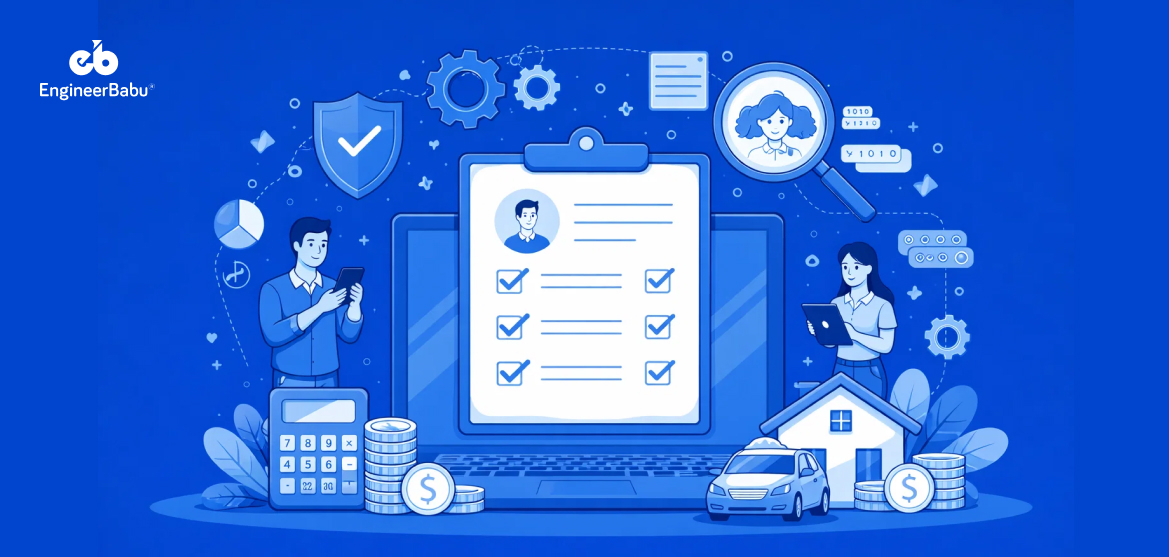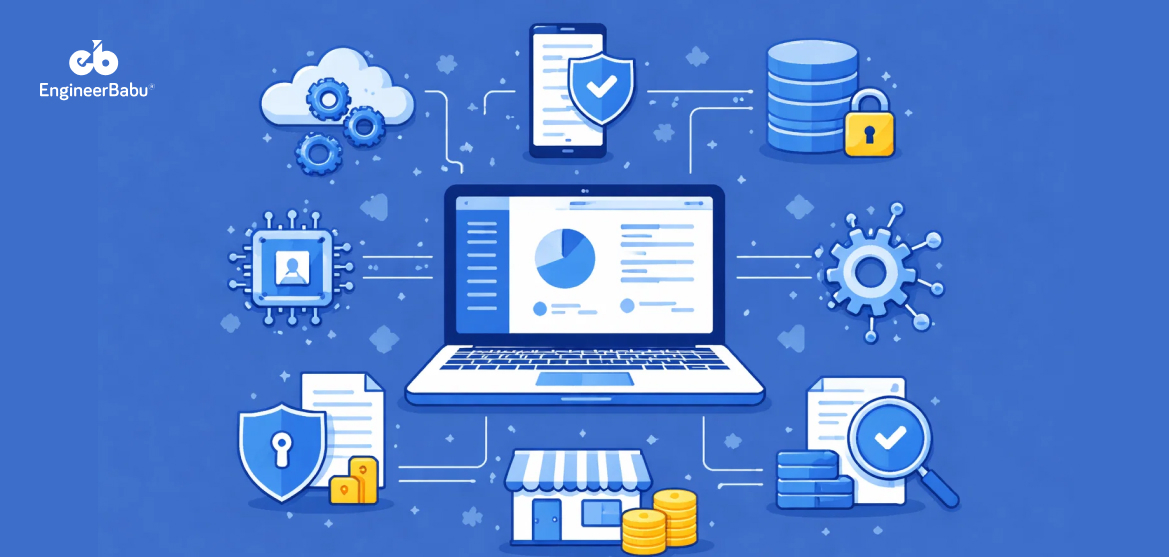Manual loan processing leaves little room for speed or accuracy. Disconnected spreadsheets, repetitive paperwork, and delayed approvals not only frustrate borrowers but also slow down lenders trying to scale. That is why more financial institutions are turning to purpose-built loan management software.
This shift to automation is no longer optional. The global market for loan management systems is expected to more than double from $10.22 billion in 2024 to $21.6 billion by 2028, growing at 20.5% CAGR (The Business Research Company). That growth reflects a clear move toward platforms that can handle higher loan volumes while staying compliant and user-friendly.
In this blog, we’ll explore the essential features of a loan management system – the capabilities that lenders need today to streamline origination, simplify repayment, and gain real-time visibility into their portfolios.
Essential Features of Loan Management Software
1. Loan Origination & Application
The origination stage sets the tone for the entire lending experience. A modern loan management system should simplify it with three core capabilities:
Digital Application Workflow: Borrowers expect to apply online without long forms or multiple visits. An intuitive workflow guides them through each step while capturing only the information that matters.
Automated Document Management: Instead of drowning staff in PDFs and scanned files, the system should use OCR and tagging to process documents automatically. Built-in KYC handling ensures verifications are faster and more accurate.
Credit Evaluation and Scoring: Real-time integrations with credit bureaus and scoring engines help lenders make informed decisions quickly. Automated checks reduce turnaround time and cut the risk of errors.
Together, these features turn origination into a fast, transparent process for both borrowers and lenders.
2. Workflow Automation & Rule Configurability
Manual approval chains slow down lending and leave room for mistakes. Loan management software solves this with automation and configurable rules that adapt to different lending models.
Configurable Loan Workflows: Every lender has unique processes. A flexible system allows teams to set custom approval paths, define loan types, and adjust eligibility rules without hardcoding changes.
Automated Decisioning Engine: Instead of relying only on manual reviews, decision engines can apply pre-set rules or machine learning models to evaluate applications instantly. This cuts approval time and reduces human bias.
Fraud Detection and Alerts: Automation is also key to risk control. Systems can flag unusual patterns, duplicate applications, or suspicious borrower activity before loans are disbursed.
With automation and configurable rules in place, lenders can scale operations without losing accuracy or control.
3. Loan Servicing & Repayment Management
Once a loan is approved, servicing becomes the backbone of the relationship between lender and borrower. This is where good software keeps things running smoothly.
Amortization and Repayment Schedules: The system should generate repayment plans automatically, adjusting for interest, tenure, or prepayments. This removes calculation errors and ensures borrowers always know what they owe and when.
Repayment Tracking: Real-time tracking of payments helps lenders spot delays quickly. Borrowers should also have clear visibility of their repayment history through a self-service portal.
Collections Management: When repayments are missed, the system should trigger reminders, late fee calculations, and, if needed, restructuring options. Automated alerts help reduce defaults while keeping borrower communication consistent.
Together, these features create a transparent repayment process that builds trust and reduces operational stress.
4. Integration Capabilities
A loan management system cannot operate in isolation. It needs to connect with external services to deliver speed and accuracy.
Payment Gateway Integration: Disbursements and repayments should flow directly through integrated gateways. This avoids manual transfers and gives borrowers multiple payment options.
Credit Bureau Connections: Pulling real-time credit scores and histories from bureaus ensures lending decisions are backed by accurate data.
KYC and AML Providers: Identity checks and anti-fraud measures should run automatically in the background, reducing delays in onboarding.
CRM and ERP Systems: For larger lenders, syncing with CRM or ERP platforms streamlines communication and financial reporting across departments.
Strong integrations make the software adaptable and prevent bottlenecks as loan volumes scale.
5. Reporting & Analytics
Good lending decisions depend on clear insights, not scattered spreadsheets. A loan management system should make reporting and analysis simple through three key features:
Dashboards and KPIs: Interactive dashboards give teams a live view of approvals, repayments, and delinquent accounts. This visibility helps lenders act quickly when issues appear.
Customizable Reports: Different roles require different information. Managers may want profitability trends, while compliance officers need audit-ready logs. The system should let each user generate the reports they need without extra effort.
Regulatory and Audit Tools: Automated compliance reports and audit trails save time during reviews and help reduce the risk of regulatory penalties. Having a fintech compliance checklist can make it easier to ensure your app meets regulatory requirements.
Together, these features ensure decisions are based on accurate, timely data rather than guesswork.
6. Scalability & Cloud Infrastructure
As loan volumes grow, the system must keep pace without slowing down. Scalability and cloud support are what make that possible.
Cloud-Based Architecture: Hosting on platforms like AWS, Azure, or GCP allows lenders to scale resources up or down as demand changes. This flexibility prevents downtime during peak lending periods.
Modular Design: A system built in modules can expand gradually. New loan products or workflows can be added without disrupting existing operations.
Performance Monitoring: Built-in monitoring tools track system performance in real time, helping teams address bottlenecks before they affect users.
With scalable infrastructure in place, lenders can grow their portfolios confidently without worrying about technical limits.
7. Security & Access Control
Loan management software handles sensitive financial and personal data, which makes strong security non-negotiable.
Role-Based Access Control: Different teams need different levels of access. Role-based permissions prevent unauthorized users from viewing or editing sensitive loan data.
Data Encryption: All information, from borrower documents to payment records, should be encrypted both in transit and at rest to protect against breaches.
Multi-Factor Authentication: Adding an extra verification step for administrators and staff reduces the risk of compromised accounts.
Audit Trails: Every action in the system should be logged. This not only strengthens accountability but also simplifies compliance checks.
Together, these controls create a secure environment that builds borrower trust and keeps the platform compliant with data protection standards.
8. User Experience & Multi-Channel Access
A loan management system should be powerful on the backend but simple for users on the front end. Borrowers and lenders expect tools that are easy to use across devices.
Responsive Interfaces: Web and mobile portals should adapt seamlessly to different screen sizes, allowing borrowers to apply, repay, or check loan status from anywhere.
Borrower-Friendly Design: Clear navigation and minimal form fields reduce friction during applications and repayments, improving completion rates.
Lender Dashboards: Custom dashboards help credit officers, managers, and compliance teams access the data most relevant to their roles without unnecessary clutter.
Multi-Language Support: For lenders operating in diverse markets, offering multiple languages ensures accessibility and wider adoption.
When usability matches functionality, the software not only streamlines lending but also strengthens trust between lenders and borrowers.
Conclusion
Every feature of a loan management software plays a practical role. Digital origination reduces drop-offs, automated workflows cut approval times, repayment tracking keeps cash flow predictable, and integrations connect lenders to the wider financial ecosystem. Reporting and analytics give teams visibility, while scalability and security make sure the system can grow without breaking.
Instead of treating these as nice-to-have add-ons, lenders should see them as the foundation of efficient, compliant, and customer-friendly lending. The difference between an ordinary platform and a strong one comes down to how well these features are planned and implemented.
FAQs
1. Which feature is most important in a loan management system?
No single feature stands alone, but digital loan origination is often the most critical starting point. Without it, the rest of the process cannot flow efficiently.
2. How do automation features help lenders?
Automation reduces manual reviews by applying predefined rules or AI-driven models to loan applications. This speeds up approvals and minimizes errors.
3. Why is repayment management a key feature?
Repayment tracking, amortization schedules, and automated collections keep cash flow predictable for lenders and reduce default risks.
4. What integrations should a loan management system include?
Essential integrations include payment gateways for disbursals, credit bureaus for scoring, KYC/AML services for compliance, and CRM systems for customer communication.
5. How does scalability affect loan management software?
Scalability ensures the system can handle higher loan volumes without downtime. Cloud-based and modular designs make it possible to expand operations smoothly as demand grows.




